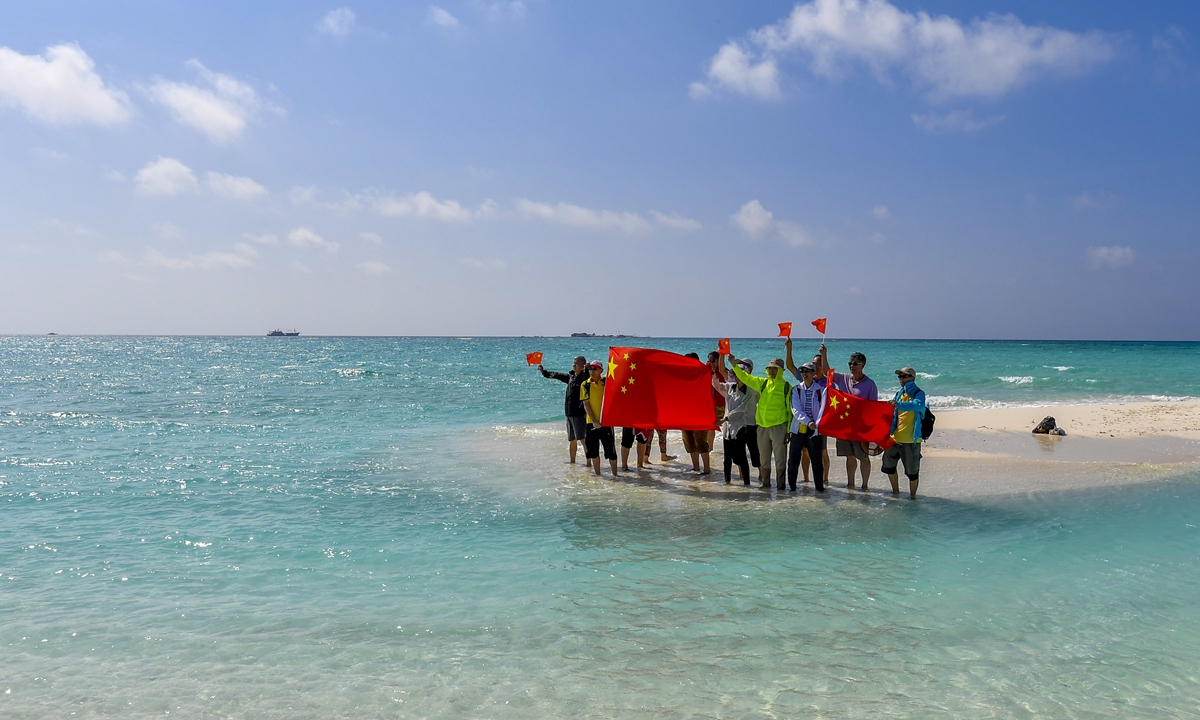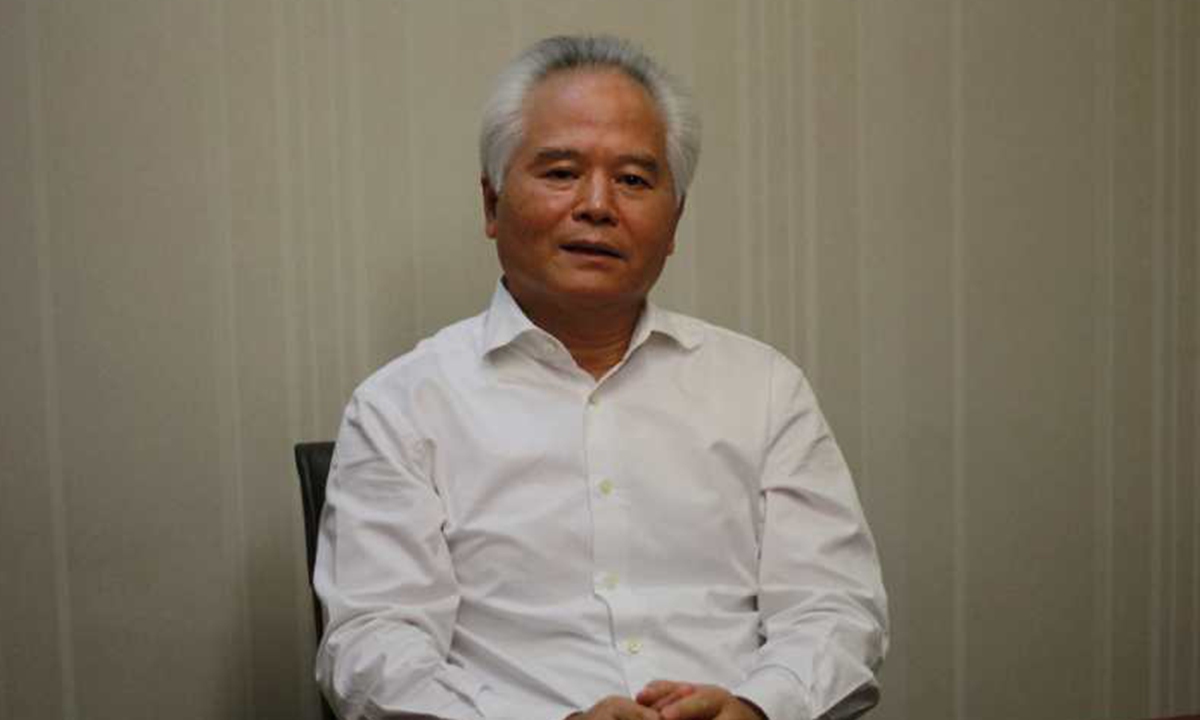By denying China’s legitimate claims, US rips off ‘fig leaf’ used to cover its vile intention in South China Sea
By Zhao Yusha and Li Sikun Source: Global Times Published: 2020/7/16 20:23:40

Visitors pose for a group photo with China's national flag at the Xisha Islands on May 21, 2019. Photo: cnsphoto

Wu Shicun, president of the National Institute for the South China Sea Studies Photo: Li Sikun/GT
Editor's Note:
US Secretary of State Mike Pompeo on Monday made a statement laden with harsh criticism against China on the South China Sea issue. The US claimed many of China's claims in this region are "illegal," despite it not even being a signatory of the UN Convention on the Law of the Sea. Washington claimed it would not allow China to build a maritime empire in the South China Sea, but the US usually trudges over thousands of miles to show off its muscle in this region.
Many analysts believed this is the first time the US formally rejected China's claims in the South China Sea region, which has altered its previous stance.
What are the fallacies and misleading rhetoric from Pompeo's statement? And what is the agenda behind Washington's change of attitude? The Global Times reporters Li Sikun and Zhao Yusha (GT) conducted an exclusive interview with Wu Shicun (Wu), president of the National Institute for the South China Sea Studies, to explain those questions.
GT: Pompeo said in a statement issued Monday "Beijing has offered no coherent legal basis for its 'Nine-Dashed Line' claim in the South China Sea since formally announcing it in 2009." Is this claim true?
Wu: This statement reflected the ignorance of Pompeo and his team. Anyone with basic historical knowledge would know that it was not the People's Republic of China who claimed the right for the "Nine Dash Line (also known as dashed lines)." In 1946, under the support of the US, the then-Republic of China government took back the South China Sea islands according to international conventions, and made a map with the dashed lines based on geographic mapping of islands in the South China Sea. In February 1948, the then-Chinese government published a map with 11 dashed lines of South China Sea islands, and officially announced the dashed lines to the international community. The old versions of the maps included eight and 10 dashed lines. The Taiwan island authority is still using 11 dashed line mapping.
After the establishment of the People's Republic of China, it inherited dashed line mapping, and the international society accepted it. Many maps in Soviet Union and maps published by nongovernmental organizations in the US cited the 11 dash lines, and labeled Nansha and Xisha islands as belonging to China.
GT: In the statement, Pompeo rejected China's claims and said the Huangyan Island and islets of Nanshan Islands are in other countries "exclusive economic zones," and that Meiji Reef and Ren'ai Reef are completely within the Philippines' sovereignty and jurisdiction. What's your comment on this?
Wu: Pompeo's statement is wrong. The first mistake would be he raised those issues based on the tribunal, which China never accepted, nor participated in the trial. Meanwhile, China does not accept any action, or statement based on the tribunal.
Also, if we trace back, China's sovereignty over Huangyan Island is recorded in history. In the 1990s, the Philippines tried to expel China and illegally take control of the island, but eventually exited in April 2012 after a standoff with China, and China began to administrate Huangyan and neighboring islands ever since.
China has sufficient historical and legal basis to claim sovereignty over Nansha Islands, an area that should be regarded as a whole. Beijing has never said it owns sovereignty over a specific island because we have sovereignty power and jurisdiction over the island as a whole. Be it Meiji Reef and Ren'ai Reef, they all are inalienable parts of the Nansha Islands.
The Philippines, in history, has illegally occupied some islands and reefs in the South China Sea five times. Since 1971, the Philippines has illegally encroached eight islands and reefs in Nanshan Islands, including Zhongye Island and Mahuan Island. Because China was embattled with the Cultural Revolution at that time, it had no spare energy to take practical action to stop the Philippines illegal occupation.
If what Pompeo said is true, that Ren'ai Island belongs to the Philippines, why did the latter not openly station there? Instead it put a tank landing ship there to hang on to it. It proved the Philippines' guilty conscious, and also proved the islands belong to China. That's why the Philippines took such a stealthy way to encroach those islands.
GT: The US statement rejects Chinese claims to waters beyond a 12-nautical mile territorial sea derived from Nansha Islands. What's your opinion?
Wu: The claims in the statement are in line with the tribunal, nothing original. The US orchestrated the arbitration, and the tribunal also comes out at the US will, that completely denied China's legitimate rights and claims.
This is Pompeo's problem: citing a tribunal that China does not accept or recognize, repeating old tunes from the tribunal and completely siding along with countries like the Philippines. Washington has entirely foregone its previous "neutral" proposition on South China Sea issue.
GT: The recent US statement has been deemed as a major shift of Washington's stance on the South China Sea issue. How have the stance and policies of the US changed on this issue?
Wu: The US policies on South China Sea have been evolving. Before the incident about Meiji Reef in 1995, the US tried to stay neutral in this region. After the Meiji Reef accident, the US began interfering in the region's issue to a limited extent. In 2010, then-Foreign Minister Yang Jiechi warned some countries not to "internationalize" the territorial dispute over the South China Sea that China faces with its neighbors, following comments by then-US Secretary of State Hillary Clinton over the issue at a regional security meeting.
Ever since then, the US began to actively involve itself in the region's affairs. Pompeo's statement on July 13 has completely ripped off the "fig leaf" of US intention to stir waves in this region. The "fig leaf" used to be the US claimed neutral stance in this region, but it was ripped off completely this time.
Why did it choose to take off the "fig leaf" now is a question we have to put it under the whole picture of souring ties between China and the US.
The US has been up the ante on pressuring bilateral ties, from trade dispute to interference with issues on Hong Kong and Taiwan, and the tension between the world's two powers has descended to confrontation on every level.
Now the US is still the only maritime super power worldwide. Its warships can sail most waters in the world without meeting any obstacles. However, the South China Sea is an exception. The US warships have been warned, or even expelled.
But currently, China is not capable of kicking the US out of the water completely, or deterring it from sailing into the water. So the US took this opportunity to weigh in. This time it only made a diplomatic statement; wrestling at the military level will continue.
GT: July 12 was the fourth anniversary of the tribunal decision. Philippine Foreign Secretary Teodoro Locsin made a statement calling for compliance with the arbitration ruling. Then Pompeo followed Locsin and made the statement. Why did those politicians make statements one after another? What's their agenda?
Wu: The US feels reluctant to accept the fact that China has treated the tribunal as a "piece of waste paper," as Washington planned the arbitration. China now has stepped up its construction on islands in the South China Sea, coupled with enhanced maritime power, which makes it harder for the US to interfere with the region's affairs.
Moreover, it is more difficult for the US to frequently conduct military exercises in the region to target China, as China's cooperation with ASEAN countries has increased. So it felt it is necessary to hype the tribunal now and to remind those countries that they have the US support on the ruling.
From the Philippine side, we can see that it has never given up the tribunal-based claims over the South China Sea issue. It has been constantly making provocations on South China Sea issue. There are a group of pro-US and anti-China politicians in Manila, who have long criticized their president Rodrigo Duterte for putting aside the tribunal. Now Duterte's upcoming step-down has given those anti-China forces in the Philippines more energy, and propelled its foreign minister to make such a ridiculous announcement.
GT: Will the recent US statement make the South China Sea region a geopolitical hotspot? And what's the US purpose for releasing such a statement?
Wu: Sometimes, the US just pays lip service, which has no significant meaning. Some countries should not be naïve to believe the US is offering them protection. For example, if China was to stop Vietnam's drilling in Wan'an Tan in the Nansha Islands, will the US weigh in to send warships and help Hanoi? I believe the US will not and dare not to do so.
So those countries should not believe that they have the US support to fight against China. That is impossible.
But we should not underestimate certain statements. Although the US sent a wrong signal, especially to Vietnam and the Philippines, some countries may actually believe it. They may form an illusion that China may hesitate to prevent their unilateral actions within the South China Sea as they were "under US protection."
GT: Pompeo said the US stands with their Southeast Asian allies and partners in protecting their sovereign rights to offshore resources. What is the ASEAN countries' reaction to the US statement, according to your observation?
Wu: Those countries are fully aware of competition between Beijing and Washington wax and wane in this region. In addition, China sits right in front of their doorsteps, and there are also economic concerns. It is hard to shake off economic dependence on China, so they feel reluctant to choose sides between the world's two major powers.
The price for choosing sides is too heavy for them to afford.
They are fully aware the US won't side along with them, and China's sanction for them if they violate China's rights on South China Sea issue is more than they could bear.
That's why countries such as Vietnam, Malaysia did not make statement after the US.
GT: Are there any countermeasures China can take to resist frequent US provocation in the South China Sea region? Some foreign media speculated China might consider declaring an "air defense identification zone" in the region as a retaliatory step. Is this possible?
Wu: Announcing an air defense identification zone is within China's realm of sovereignty, but it could hurt ASEAN countries more than the US, in return damaging ties between China and ASEAN countries.
The US indeed has some arrows in their quiver on this issue. But China's strength in this region is also increasing, whilst US influence and advantages in this area are receding and declining. That is why the US wanted to use the tribunal to wrestle with China this time.
China should not panic. We need to know that the US won't have much more practical new moves. Thus we need to integrate our maritime power and study the changes in the mode of future maritime war, and form our own deterrence force.
Newspaper headline: Sea of inheritance